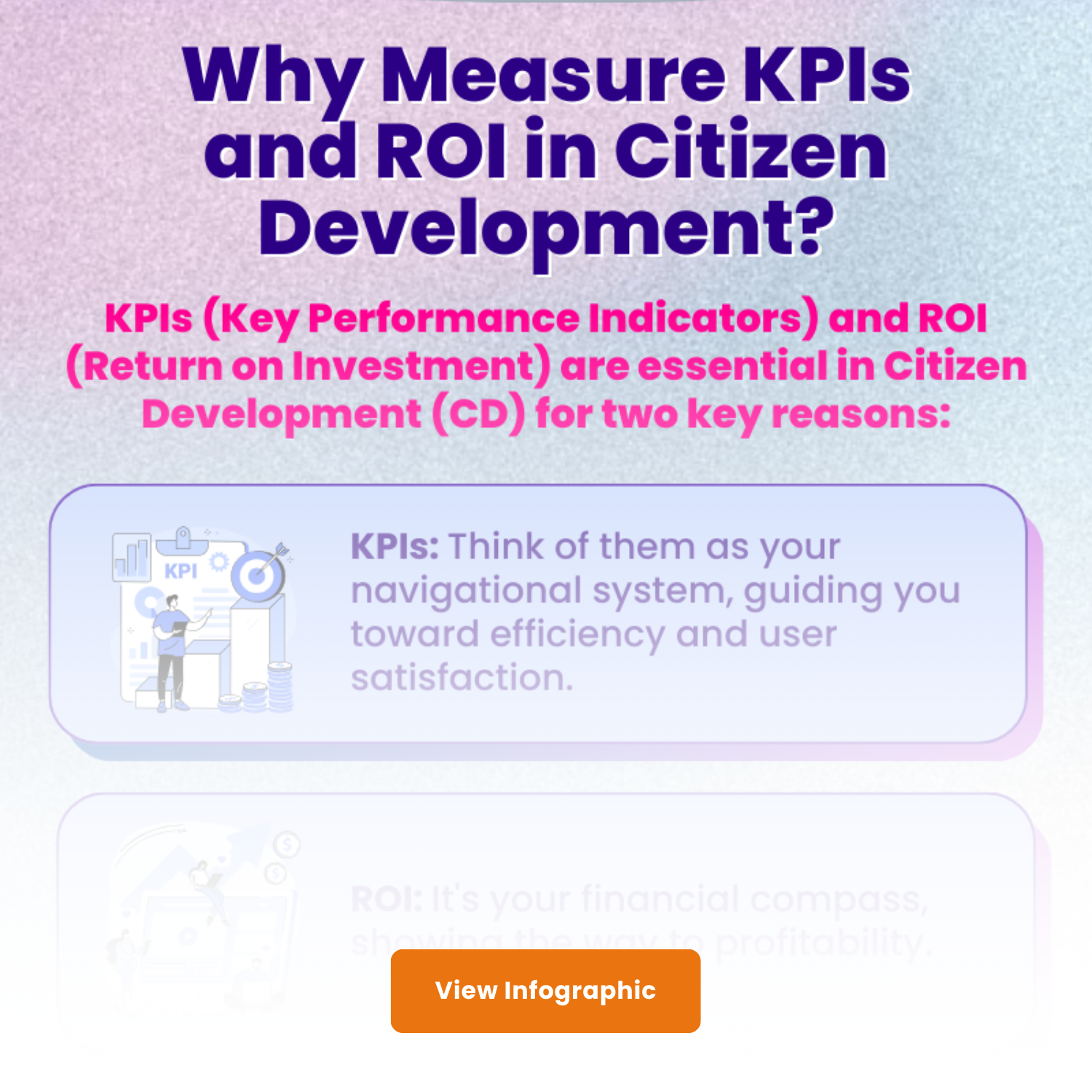The rise of citizen development stands as a beacon of change. It empowers non-technical minds to take the reins of innovation, crafting applications that propel organizations forward. This phenomenon ignites agility, efficiency, and a surge of creativity. Yet, beneath the surface lies a critical challenge – measuring the impact. Enter the realm of Return on Investment (ROI) and Key Performance Indicators (Citizen development KPIs), the compass guiding project success. This blog is about ROI & KPIs as per CD perspective, unraveling how they illuminate the path to value and innovation. Let’s learn how this metric charts the course toward a brighter, more empowered future.
Understanding the Significance of Citizen Development KPIs
Imagine a world where innovation knows no boundaries, where non-technical employees wield the power to create groundbreaking applications. Welcome to the realm of citizen development! But as this revolutionary force takes center stage, how do you measure its true impact? The answer lies in the art of Key Performance Indicators (KPIs) – the magic compass guiding your success in the land of data-driven innovation.
The Role of KPIs in Measuring Citizen Development Success
KPIs play a central role in evaluating the effectiveness of citizen development initiatives. By providing objective measurements, KPIs enable organizations to assess progress, identify areas of improvement, and make informed decisions. The right set of KPIs ensures that organizations can gauge the value and ROI of their citizen development efforts, driving continuous improvement and success.
Defining Citizen Development KPIs: Purpose and Importance
Before delving into specific KPIs, it’s essential to grasp the purpose and significance of these metrics in the context of citizen development. KPIs provide actionable insights, acting as performance indicators that align with organizational goals and objectives. By measuring progress against predefined targets, KPIs help organizations understand their CD initiatives’ effectiveness, identify improvement areas, and ensure continuous growth and innovation.
How KPIs Contribute to Continuous Improvement and Innovation
KPIs act as catalysts for continuous improvement and innovation. By monitoring KPIs regularly, organizations can identify bottlenecks, measure progress, and drive positive changes in their citizen development processes. This data-driven approach fosters a culture of innovation, allowing teams to explore new ideas, experiment, and implement improvements for enhanced performance.

Types of KPIs in Citizen Development: Leading vs. Lagging Indicators
In Citizen Development (CD), Key Performance Indicators (KPIs) come in two flavors: leading indicators and lagging indicators. Let’s break it down!
Leading indicators
They are like early warning signs. They give us a heads-up about what might happen in the future. It’s like seeing storm clouds on the horizon – you know a storm might be coming, so you grab your umbrella before it starts pouring.
Why Leading Indicators Matter
Leading indicators help us be proactive. They give us hints about potential problems or opportunities ahead of time. Imagine you’re baking cookies and notice the dough isn’t sticking together as it should. This could be a leading indicator that you need to adjust the recipe before you pop them in the oven.
Lagging indicators
on the other hand, are like looking at the tracks left behind. They show us what’s already happened. Think of it as looking at footprints in the sand – you can tell where someone has been, but it’s after they’ve already walked that path.
Why Lagging Indicators Matter
Lagging indicators are like looking at the final score of a game. They help us see how well we did after all is said and done. For instance, if you’ve been working hard to improve your running speed, looking at your previous race times can show you how much progress you’ve made.
In Citizen Development, using both types of indicators helps us stay on top of things. Leading indicators prepare us for what’s coming while lagging indicators help us learn from what’s already happened. So, whether you’re predicting the weather or improving your skills, these indicators have your back!
Also Read: 11 Questions you must Answer before implementing Citizen Development
Identifying Relevant KPIs for Citizen Development Success
Selecting the right KPIs is critical to gauge the success of citizen development initiatives accurately. It involves aligning KPIs with the specific business goals and objectives that citizen development seeks to address. For instance, if the primary goal is to improve operational efficiency, relevant KPIs may include process automation, time-to-delivery, and resource utilization metrics. Additionally, organizations should consider the nature of their citizen-developed apps and tailor KPIs to suit individual use cases.
To comprehensively measure the impact and performance of citizen development, several essential KPIs come into play:
Time-to-Value: Tracking Speed and Efficiency of App Delivery
Time-to-value measures the speed and efficiency of app development and delivery. It indicates how quickly citizen-developed apps can address specific business needs and become operational, providing immediate value to the organization.
App Adoption Rate: Evaluating User Engagement and Utilization
App adoption rate measures the level of user engagement and utilization of citizen-developed applications. A high adoption rate signifies that the apps are well-received by users and effectively address their needs.
App Quality and User Satisfaction: Gathering User Feedback
Gauging app quality and user satisfaction is crucial for continuous improvement. Collecting user feedback allows organizations to identify areas for enhancement, ensuring that the apps meet user expectations and requirements.
Productivity and Efficiency: Measuring Impact on Business Processes
Measuring productivity and efficiency assesses how citizen-developed apps have streamlined business processes, reduced manual efforts, and improved overall productivity.
Cost Savings and ROI: Calculating Financial Benefits
Calculating cost savings and ROI provides a quantitative measure of the financial benefits resulting from CD initiatives. It validates the organization’s investment in citizen development and helps prioritize future development efforts.
Measuring ROI in Citizen Development with Real-Time Insight
When it comes to measuring ROI in citizen development, a cutting-edge strategy is reshaping the landscape – and it’s all about real-time insights. Relying solely on historical data falls short. Instead, envision a scenario where you harness real-time usage data to paint a vivid, up-to-the-minute portrait of your application’s performance. This approach isn’t just a mere perspective shift; it’s a profound journey of perpetual refinement.
By remaining closely attuned to the ever-evolving pulse of real-time usage, you’re not merely assessing ROI but actively crafting and optimizing it as you go. This represents the future of ROI assessment, where success lies in capturing and leveraging the vibrancy of the present moment.
ROI (Return on Investment) in Citizen Development
Return on Investment (ROI) of citizen development projects refers to the measure of the financial gain or loss generated by a specific initiative compared to the resources invested in it. It quantifies the profitability of the initiative and provides insights into whether the benefits obtained, such as increased operational efficiency, revenue growth, or cost savings, outweigh the costs incurred, including training, development, and maintenance expenses. A positive ROI indicates that the citizen development initiative has yielded a favorable return relative to its investment, showcasing its viability and contribution to the organization’s financial goals.
Interested in understanding the possible cost savings (ROI) achievable by integrating Quixy as the Business Process Management (BPM) platform for streamlining workflows and processes across your company. Use our ROI calculator!
Measuring ROI and Overcoming Common Challenges
Measuring the Return on Investment (ROI) of citizen development projects is crucial for organizations to understand the value and effectiveness of their initiatives. However, several common challenges can impede the accurate measurement of ROI. This article explores the key challenges organizations may face when measuring the ROI of citizen development and suggests strategies to overcome these obstacles.
Challenge 1: Quantifying Intangible Benefits
One significant challenge in measuring the ROI of CD is quantifying intangible benefits. While financial gains are relatively straightforward to assess, intangible benefits such as increased employee satisfaction or improved collaboration are harder to quantify in monetary terms. To overcome this challenge, organizations can conduct surveys and interviews to gather qualitative feedback from users, which can then be analyzed to determine the indirect value generated by citizen development projects.
Challenge 2: Aligning Metrics with Business Objectives
Another challenge is aligning the metrics used to measure ROI with the organization’s overarching business objectives. CD projects should ultimately contribute to the achievement of strategic goals, but finding the right metrics to assess this alignment can be tricky. To address this challenge, organizations should establish clear evaluation criteria that directly tie metrics to strategic goals. This ensures that the ROI measurement is aligned with the broader business objectives and provides a more accurate representation of the value delivered.
Challenge 3: Ensuring Accurate Data Collection
Accurate data collection is vital for measuring the ROI of CD project. Organizations must gather reliable and relevant data to evaluate the impact of these projects. However, data collection can be challenging due to factors like data silos, inconsistent reporting, or incomplete data sets.
Also Read: How can lack of Governance fail No-Code and what’s the solution?
Strategy to Overcome ROI Challenges
To overcome this challenge, organizations should implement comprehensive data-tracking systems that capture relevant information throughout the project lifecycle. This enables the collection of accurate and consistent data for ROI analysis.
Strategy 1: Conduct User Surveys and Interviews
To address the challenge of quantifying intangible benefits, organizations can conduct user surveys and interviews. These methods allow users to provide feedback on their experiences with citizen development projects, highlighting the intangible benefits they have gained. By analyzing this qualitative feedback, organizations can better understand the indirect value generated and factor it into the ROI calculation.
Strategy 2: Establish Clear Evaluation Criteria
To overcome the challenge of aligning metrics with business objectives, organizations should establish clear evaluation criteria. This involves defining specific metrics that directly align with the strategic goals of the organization. By clearly linking the metrics used for ROI measurement to the business objectives, organizations can ensure that the evaluation accurately reflects the contribution of citizen development to overall organizational success.
Strategy 3: Implement Comprehensive Data Tracking Systems
To ensure accurate data collection, organizations should implement comprehensive data tracking systems. These systems should capture relevant data points at various stages of the CD project. By leveraging technology and automation, organizations can streamline data collection processes and minimize the chances of data discrepancies. This enables more accurate and reliable ROI calculations.
Optimizing Citizen Development Programs with KPI Data
Leveraging KPI data enables organizations to optimize their CD programs and improve outcomes. By analyzing the data, organizations can identify areas of improvement, allocate resources effectively, and make data-driven decisions. For example, if KPI data reveals high bug counts, organizations can focus on enhancing quality assurance processes. Continuous monitoring and evaluation of KPIs allow organizations to fine-tune their programs, enhance performance, and drive better outcomes. By harnessing KPI data, organizations maximize the impact of their citizen development initiatives and foster continuous improvement.
Aligning KPIs with Business Goals and Objectives
To ensure the relevance and effectiveness of KPIs, it is essential to align them with the broader business goals and objectives. By aligning KPIs with strategic priorities, organizations ensure that citizen development efforts contribute directly to the organization’s growth and success.
Importance of Tailoring KPIs to Specific Use Cases
Citizen development encompasses a wide range of use cases across various departments and functions. Tailoring KPIs to specific use cases ensures that the metrics measured are relevant and accurately reflect the outcomes of citizen development efforts.

Also Read: Unleash the Potential of your team: Citizen Development for Business Users
Conclusion
Measuring ROI and tracking KPIs are integral to the success of CD projects. Organizations can effectively evaluate the impact of their citizen development initiatives by aligning KPIs with organizational objectives, monitoring metrics throughout the ideation and deployment phases, and focusing on user satisfaction and real-time usage. Through continuous improvement and a comprehensive understanding of the broader business context, organizations can maximize the benefits and value generated by citizen development projects, ensuring continued success in an ever-evolving digital landscape empowering business users.
Citizen development opens up a world of possibilities, allowing organizations to harness their workforce’s collective creativity and ingenuity. By implementing the right KPIs and measuring ROI effectively, businesses can navigate their citizen development implementation journey with confidence, driving innovation, efficiency, and success in the digital age. The key to thriving in this fast-paced era lies in the data-driven approach of citizen development – a pathway to unlock limitless potential, transform ideas into reality, and elevate your organization to new heights. Start your citizen development assessment and elevate your organization’s innovation game!
Frequently Asked Questions (FAQs)
Q. What is the difference between Citizen Development KPI and ROI?
Citizen Development KPIs provide a comprehensive view by measuring performance aspects such as user engagement, process efficiency, and collaboration within projects. ROI, on the other hand, specifically gauges the monetary returns generated by a project. While KPIs offer insights into various project dimensions, ROI quantifies the direct financial gains, highlighting the distinct roles these metrics play in evaluating project success.
Q. Why is ROI crucial for assessing citizen development success?
ROI holds significance in evaluating citizen development because it quantifies the financial benefits obtained from the project. It serves as a tangible measure to ascertain whether the resources invested yield profitable outcomes. By assessing ROI, organizations can determine the actual financial impact of citizen development initiatives, aiding in informed decision-making and resource allocation.
Q. What are essential KPIs for measuring citizen development impact?
Essential Key Performance Indicators (KPIs) for measuring citizen development impact encompass user adoption rates, project completion time, efficiency improvements, and the number of successful citizen-led projects. These KPIs collectively provide insights into the effectiveness of citizen development efforts, allowing organizations to gauge improvements and outcomes.
Q. How do citizen development influences overall business ROI?
Citizen development projects positively influence overall business ROI through multifaceted mechanisms. These projects enhance operational efficiency, improve processes, and reduce costs by enabling non-technical staff to create streamlined solutions using no-code. As a result, the cumulative effect of numerous citizen-led projects contributes to an increased organizational ROI by driving enhanced productivity and resource optimization.
Q. What is the difference between Citizen Development KPI & ROI?
Citizen Development KPIs measure the performance and impact of applications created by non-professional citizen developers. ROI evaluates the financial profitability of an investment, including development costs. KPIs focus on application quality and user adoption, while ROI assesses financial gain relative to expenses.
Subscribe
Login
Please login to comment
0 Comments
Oldest















